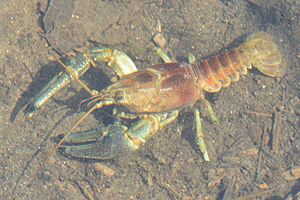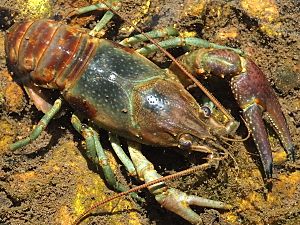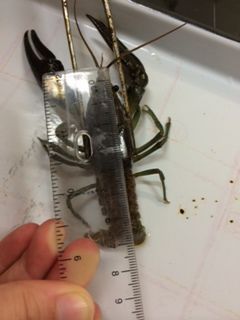Rusty crayfish facts for kids
Quick facts for kids Rusty crayfish |
|
|---|---|
 |
|
| Rusty crayfish (Faxonius rusticus) in Guelph, Ontario, Canada | |
 |
|
| Rusty spots on sides of carapace | |
| Conservation status | |
| Scientific classification | |
| Genus: |
Faxonius
|
| Species: |
rusticus
|
| Synonyms | |
|
|
The rusty crayfish (Faxonius rusticus) is a large and tough type of crayfish that lives in fresh water. It originally comes from the Ohio River area in the United States, including parts of Ohio, Kentucky, and Indiana. These crayfish are now spreading quickly across eastern North America. They are taking over places where native crayfish used to live.
The rusty crayfish was first found in Illinois in 1973. By 2005, it had even reached the John Day River in Oregon, west of the Continental Divide.
Contents
About the Rusty Crayfish
What They Look Like
Adult rusty crayfish can grow up to 10 centimeters (about 4 inches) long. They are ready to have babies when they are about 4.4 centimeters (1.7 inches) long. Their color can be greenish-grey or reddish-brown.
You can easily spot them by two reddish, "rusty" looking spots on the sides of their back. They also have big front claws with black bands near the tips. Male rusty crayfish have small hook-like parts on their first pair of back legs. They use these hooks to hold onto a female during mating.
How They Behave
Many animals, including some vertebrates (animals with backbones) and even some invertebrates (animals without backbones), create a "pecking order" or dominance hierarchy. This helps them set up who is in charge in their group. For crayfish, this order is very important to how they live.
Crayfish often form these groups with others in their area. The biggest male usually shows the most power by being the most aggressive. He might pick fights with smaller crayfish. The crayfish that wins the most fights becomes the leader. Other crayfish usually rank below him based on their size and whether they are male or female.
Rusty Crayfish as an Invasive Species
Why They Cause Problems
Rusty crayfish are bigger and more aggressive than many native fish are used to. This makes it harder for fish to eat them. Instead of running away from a predator like native crayfish do, the rusty crayfish will stand its ground. It raises its claws above its head, which often scares away fish that want to eat it. Also, adult rusty crayfish can be too big for some fish to swallow.
Because rusty crayfish are so good at avoiding predators, their numbers grew very fast in new places. Within about 20 years, their population exploded. They became an invasive species in the Northern United States and parts of Canada. These rusty crayfish have taken over the homes of native crayfish. This has caused many native crayfish populations to shrink a lot over the last 50 years. The rusty crayfish is now the main type of crayfish in much of the Midwestern United States.
Controlling Their Spread
There are some chemicals that can kill crayfish, but they kill all types of crayfish, not just the rusty ones. These chemicals are not approved for general use. One way to help control them is by catching them for people to eat, since they are quite large. However, this mostly helps reduce the number of adult crayfish.
Once rusty crayfish are in a body of water, it is very hard to get rid of them completely. So, the best way to control them is to stop them from spreading to new places. You can help by learning to identify rusty crayfish. Also, never use them as bait when fishing, and do not move them to new lakes or rivers where they are not already living.





